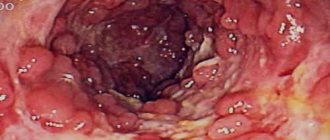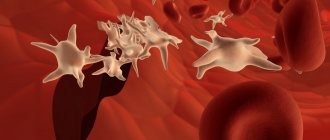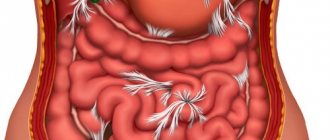Hepatitis is an inflammatory liver disease; due to damage to the liver tissue, a significant deterioration of the general condition of the body occurs. With an asymptomatic course of the disease and in the absence of timely treatment, hepatitis becomes chronic and eventually leads to cirrhosis of the liver and cancer.
When it enters the human body, the hepatitis virus infects the liver tissue, causes inflammation in it, and then the liver parenchyma is gradually replaced by connective tissue. During this period, the main functions of the organ are disrupted. Thus, the liver stops producing enzymes necessary for blood clotting and the digestion process. The level of bilirubin (bile pigment) in the blood increases, and jaundice appears. It manifests itself most clearly on the skin, mucous membrane of the soft palate and sclera.
Due to a blood clotting disorder, the slightest blows cause serious hematomas and the threat of internal bleeding. In the absence of proper treatment or severe disease, the liver cells are increasingly affected, the set of symptoms becomes brighter, the liver increases in size and completely ceases to perform its functions. Hepatitis at this stage is fatal.
Hepatitis A virus (HAV)
Hepatitis A accounts for one and a half million cases in the world every year, which is very far from the truth, because for every patient with clinical manifestations of the disease, there are five with a silent form that proceeds hidden from the virus carrier himself. But five is the minimum; it is possible that there are many more. Such victims of hepatitis are identified after the fact during testing, leading to unpleasant surprise. In the Fatherland, hepatitis A firmly takes the place of leader among its fellow infectious hepatitis.
This is an RNA-containing virus, designated as Hepatitis A virus (HAV) or by its first letters HAV, by and large this is not so important to everyone except specialists, the main thing is that this virus is extremely persistent.
- The hepatitis A virus will quietly persist for several months anywhere, as long as the temperature does not drop below +4°C.
- Will withstand boiling for up to half an hour.
- It is not killed by hydrochloric acid of gastric juice.
- The virus does not like bleach and formaldehyde, but only if you soak it for at least half an hour.
- Ultraviolet light destroys the hepatitis A virus.
Preventive measures
The main prevention of hepatitis is strict adherence to hygiene rules.
Be sure to wash your hands with soap before eating and after using the toilet, do not eat dirty vegetables and fruits, and use only your own personal hygiene products.
To prevent serum hepatitis, you need to be careful when choosing a medical institution.
Thus, in public clinics, control of the sterility of instruments is carried out more strictly. If possible, use disposable instruments (syringes, gynecological kits, catheters, etc.).
It is important to lead a healthy lifestyle, give up bad habits, and adhere to healthy eating rules.
There are vaccines for hepatitis A and B.
Video on the topic: Hepatitis. Live Healthy!
What kind of virus is this?
There are many strains—varieties of the virus—and in each region there are both native and foreign, as many strains of hepatitis A viruses live as they want. But you should not be afraid, because infection occurs only from a patient, everything is very strict with this, viral hepatitis - absolute anthroponosis, which is tolerated by man and only man. But to become infected with hepatitis A, just a few pathogens are enough; the patient begins to secrete the virus several days before the disease manifests itself and for a whole week with jaundice, it can infect others for up to 5 weeks.
Take care of yourself, book a consultation now
WHO activities
In May 2021, the World Health Assembly adopted its first-ever Global Health Sector Strategy on Viral Hepatitis 2016–2021. It highlights the critical importance of achieving universal health coverage and sets targets aligned with the Sustainable Development Goals. The overarching goal of the strategy is to eliminate viral hepatitis as a public health problem, which is reflected in global targets to reduce the number of new cases of viral hepatitis infection by 90% and mortality from viral hepatitis by 65% by 2030. The strategy sets out the measures that countries and the WHO Secretariat must take to achieve these objectives.
To support countries in achieving global hepatitis targets under the 2030 Agenda for Sustainable Development, WHO is working in the following areas:
- raising awareness, facilitating partnerships and mobilizing resources;
- developing evidence-based policies and generating data to inform action;
- improving health equity in the hepatitis response;
- prevention of the spread of infection; And
- expanding coverage of screening, care and treatment services.
Since 2011, WHO has worked with countries, civil society and partners to organize annual events to mark World Hepatitis Day (one of the nine major annual health campaigns) to raise awareness and understanding of the problem. viral hepatitis. This day is held on July 28 to honor the birthday of Nobel Prize-winning scientist Dr. Baruch Blumberg, who discovered the hepatitis B virus and developed a diagnostic test and vaccine against the virus.
World Hepatitis Day 2021 will be held under the theme “A future without hepatitis” and will focus on the prevention of hepatitis B among mothers and newborns. On 28 July 2021, WHO will publish new recommendations for the prevention of mother-to-child transmission of the virus.
- An epidemic of hepatitis A attributable to the ingestion of raw clams in Shanghai, China. Halliday ML1, Kang LY, Zhou TK, Hu MD, Pan QC, Fu TY, Huang YS, Hu SL. J Infect Dis. 1991 Nov;164(5):852-9.
- Hepatitis A virus seroprevalence by age and world region, 1990 and 2005. Jacobsen KH, Wiersma ST. Hepatitis A virus seroprevalence by age and world region, 1990 and 2005. Vaccine 28 (2010) 6653–6657.
How does hepatitis A enter the body?
With dirty hands, the virus enters the mouth, from there into the stomach, and it does not care about the hydrochloric acid of the gastric juice; it reaches the small intestine, where it multiplies in the cells of the mucous membrane and enters the blood, migrating to its favorite organ - the liver. In liver cells, it multiplies again, irreversibly destroying them. In addition to the viral frenzy, the liver’s own immune cells rush to the liver, which also destroy hepatocytes filled with viruses, but do not allow the virus to penetrate further.
The stronger the body's immune response to the virus, the more liver cells will be killed. War is war, the warring parties spare nothing.
The liver is destroyed by hepatitis A for a long time, and at this time the virus itself slowly migrates with bile into the intestine and leaves the body with feces. The liver slowly and difficultly begins to restore itself, literally cell by cell, fortunately, it has been given such a great opportunity - to replace lost cells, even if not all 100% of the dead, but some part of the dead will be replaced by new hepatocytes. The virus will go away, leaving lifelong immunity to it and antibodies floating in the blood, which tell us that the person once had viral hepatitis A. These antibodies are very specific, clearly indicating hepatitis A, and no other.
How does the disease progress - symptoms of hepatitis
After infection with the hepatitis A virus, the disease does not occur immediately, but after some time; I call it the incubation period, approximately from two weeks to a month, but not less than 5 days and not more than 50. This is the time from the penetration of the virus inside until the first wave of reproduction in cells colon mucosa.
This is followed by a prodrome, when a person develops symptoms of an intestinal infection, or maybe just weakness and nothing more. High temperature, aches in muscles and joints, headache - you will never suspect that this is not just the flu, but a real viral hepatitis.
Why is it impossible to distinguish between infections during this period, unless blood tests are taken? Because the clinical picture at this time is due to the spread of the virus in the blood. This happens with any viral infection, but specific liver damage, which distinguishes hepatitis from all others, is ahead.
During the prodromal period, several clinical scenarios are possible. This is the flu-like illness described above. Almost the same symptoms, but nausea and vomiting come to the fore, sometimes diarrhea - a dyspeptic variant. Asthenovegetative is not much like the flu; weakness without fever prevails. If it doesn’t look like anything specific, then it’s a mixed version, in which anything can happen.
Jaundice
This can continue for up to a week. Usually even during this period they are not wary, meanwhile, the patient is already contagious to others. But if the patient tells the doctor that on the third or fourth day of the flu the urine darkened and the stool became lighter, a diagnosis of hepatitis will be made at that very moment. Some yellowness of the sclera will appear - icterus, then the oral mucosa will acquire a yellow tint and finally the skin will become colored. The yellowness of the skin will increase to maximum color for almost a week. But the condition will improve somewhat: there will be no fever, the feces will become completely white, and the urine will be the color of dark beer. The weakness will remain and there will be no appetite for quite a long time. It will take a couple of months to recover.
Possible options
But hepatitis A does not always go so well. In those weakened by chronic diseases, in the elderly, and in the immunodeficient, a lightning-fast scenario of acute hepatitis can play out, when, within a few hours, acute brain damage develops from the products of a decaying liver with some inadequacy of consciousness. Blood clotting disorders are added: bruises appear just like that - at the injection site, nosebleeds begin for no apparent reason, vomit turns brown - this is blood sweating through fragile vessels. On the 4th–5th day of jaundice, hepatic coma develops, from which death is not even three steps away.
Viral hepatitis can be mild, moderate or severe, everything is determined by the intensity of the symptoms of intoxication and the severity of jaundice. With a mild form, the condition is almost normal; jaundice lasts 2–3 weeks. With moderate severity, all the symptoms of hepatitis are pronounced, and the yellowness of the skin lingers for up to a month. Well, a serious illness can last up to 2 months; this is more typical for older patients with chronic liver diseases, alcoholics and pregnant women.
Patients with moderate and severe forms are hospitalized in an infectious diseases hospital for adequate treatment, but specific antiviral drugs specifically for destroying the hepatitis A virus in the body do not yet exist. All treatment is symptomatic: only relieving the painful signs of the disease, helping to remove the breakdown products of hepatocytes and stimulating a speedy recovery.
Symptoms and diagnosis of the disease
The symptoms of different types are slightly different.
Hepatitis A is characterized by the following symptoms:
- temperature increase;
- feeling unwell, aching;
- vomiting, diarrhea;
- pain in the area of the affected organ (right hypochondrium), enlargement of the liver;
- mucous membranes and skin acquire a yellowish tint (but not always);
- urine becomes dark in color and stool becomes discolored.
The disease can be diagnosed by complaints of characteristic symptoms, by an apparently enlarged liver, and by a blood test for antibodies to hepatitis.
Hepatitis B manifests itself in the same way as A. Only jaundice is more pronounced and there may be skin rashes accompanied by itching. The disease becomes chronic in 10% of cases.
To determine the disease, there are special rapid tests that can be purchased at a pharmacy and can be used to determine the presence of the disease at home.
Hepatitis C is characterized by:
- prolonged feeling of weakness, fatigue;
- sleep disorders;
- decreased performance.
For diagnosis, the patient's blood is examined. Sometimes it is necessary to take tissue from the affected organ to analyze the destruction.
The symptoms of hepatitis D are similar to those of type B, but are more severe. The picture of hepatitis E is similar to type A. But the pain is more acute and more pronounced.
To diagnose the disease, a clinical analysis is performed to determine the level of bilirubin and liver enzymes.
If alarming symptoms appear, you should consult a doctor to be tested for the presence of antibodies to hepatitis. Regular examinations should be carried out for persons at risk for this disease.
How to protect yourself from hepatitis A
The slogan “Cleanliness is the key to health” is relevant at all times, but there is also an effective vaccine against hepatitis A, which will be provided free of charge at any time in any public clinic. Mandatory vaccination is recommended for children, adults suffering from liver diseases, certain categories of workers who have contact with feces, homosexuals, residents of natural disaster areas and everyone else.
It is necessary to make two injections with an interval of six months to 6 years; already the first dose within a month will give a high level of antibodies to the virus and can protect a person who has had contact with a sick person no later than two weeks. Immunity lasts for almost two decades. The safety of the vaccine is approaching absolute safety. Vaccination is especially important in the absence of specific treatment for viral hepatitis A.
The material was prepared by an infectious disease specialist at the Medicine 24/7 clinic, Doctor of Medical Sciences Margarita Vasilievna Nagibina.
Treatment
Any type of disease requires medical supervision. Treatment is provided by infectious disease specialists, gastroenterologists, and hepatologists. After identifying the disease and assessing the degree of liver damage, appropriate therapy is prescribed.
Treatment can last from a month to a year or longer. The earlier therapy is started, the better the prognosis.
Drug treatment
Treatment of hepatitis is expensive and lengthy. Medicines have strong side effects. In each specific case, drugs are selected individually. Treatment usually includes nucleoside analogues and interferons. Their combination prevents the proliferation of viruses and protects liver cells from destruction. Symptomatic treatment is also carried out, and medications that support the liver are prescribed. It is important to follow an appropriate diet.
Folk remedies
Traditional medicine methods are used as adjuvant therapy in the treatment of hepatitis. It is advisable to consult your doctor first.
The most popular means:
- Warm poultices applied to the liver area to reduce pain.
- Corn silk tea. Course – 6 months.
- Calendula infusion as a choleretic agent.
- St. John's wort infusion has an anti-inflammatory effect.
- Dissolve vegetable oil on an empty stomach in the morning.
- Brew a mixture of chicory, horsetail, yarrow and St. John's wort.
- Milk thistle decoction or tincture.









